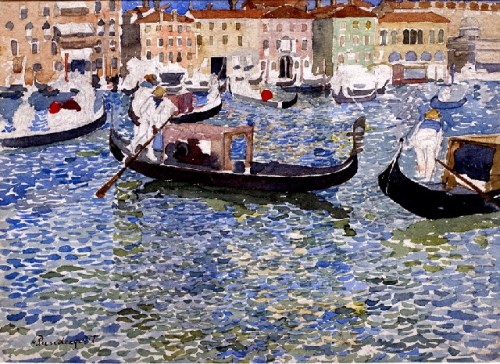Prendergast in Italy at Williams College Museum of Art
Exhibition Opens on July 18
By: Ariel Petrova - Mar 25, 2009
In partnership with the Terra Foundation for American Art, the Williams College Museum of Art (WCMA) presents "Prendergast in Italy," the first exhibition devoted entirely to the watercolors, monotypes, and oil paintings by American artist Maurice Prendergast. Featuring over sixty views of Venice, Rome, Siena, and Capri, "Prendergast in Italy" also includes the artist's personal sketchbooks, letters, photographs, and guidebooks from his two trips to Italy in 1898 and 1911. Prendergast presented a view of Italy that was informed by European trends but did not disguise his strong American accent—an accent that would come to dominate international discourse in the twentieth century. This interdisciplinary exhibition demonstrates the advances of abstract color and form that put Prendergast on the cutting edge of American modernism.
Since the majority of the works are of Venice, the armchair traveler will come away from this exhibition with a vivid sense of that unique city, its canals, and famous monuments as seen though the eyes of an American on the forefront of 20th-century modernism. Five different works, including "Rialto, Venice" from WCMA's collection, are displayed so that both sides are visible. These double-sided watercolors, in addition to many sketches and unfinished works, provide a special glimpse into the artist's creative process. A large group of color monotypes showcase Prendergast's daring approach and experimentation with the medium. Archival materials, such as photographs, letters, guidebooks, and Japanese prints belonging to the Prendergasts (now in WCMA's collection), give context to the period and Prendergast's unique, modern style.
"Prendergast in Italy" highlights a selection of the collection of over four hundred works by artist-brothers Maurice and Charles Prendergast in the Williams College Museum of Art, the largest collection in the world. In addition to artworks from WCMA and the Terra Foundation for American Art, the exhibition features loans from over fifty institutions and private collections in the United States, including the Metropolitan Museum of Art, the Museum of Modern Art, the National Gallery of Art, and the Museum of Fine Arts, Boston.
"Prendergast in Italy" opens at the Williams College Museum of Art on Saturday, July 18 and will be on view through September 20, 2009; the exhibition then travels to the Peggy Guggenheim Collection, Venice, Italy (October 9, 2009–January 3, 2010), and the Museum of Fine Arts, Houston, Texas (February 14–May 9, 2010).
"Prendergast in Italy" was conceived and organized by Nancy Mowll Mathews, Eugénie Prendergast Senior Curator of 19th and 20th Century Art at the Williams College Museum of Art, Williamstown, Mass., with Elizabeth Kennedy, Curator of Collection at the Terra Foundation for American Art, Chicago, IL.
About the Artist
Maurice Prendergast (American, 1858–1924) made a name for himself in Boston and New York as a cutting edge Impressionist watercolorist who experimented with color monotypes. In his day, he was lauded by the more progressive art critics and attracted the support of modern art collectors. When he first departed for Italy (1898), he was an up-and-coming avant-garde artist who had recently returned to Boston from four years in Paris.
The body of work that Prendergast produced shows his struggle to pay homage to the great art he encountered in Assisi, Siena, Rome, and Venice while he grappled with the new realities of modern, unified Italy and the progressive art of his time. Prendergast's interpretation of Venice captures a unique blend of old and new. Watercolors from his first trip to Italy are characterized by Prendergast's interest in the Italian flag and how it symbolized a "new" Italy; he depicted it many times during this first trip. These works were sent home and exhibited in Boston even while he was still abroad. In 1900, shortly after his return to America they were showcased in his first one-person show. It was the Italian watercolors that catapulted Prendergast to a national reputation and a place among the most advanced artists in New York.
Ten years later, after assimilating the new expressionistic and abstract art theories unveiled in Paris by Matisse, Picasso, and their circle, Prendergast again departed for Italy (1911). On his second trip, Prendergast focused on the bridges of Venice, applying his new style to the emblematic architecture of the canal city. This body of work shows the advances of abstract color and form that put Prendergast at the forefront of American modernism.
Sponsorship
"Prendergast in Italy" is organized by Williams College Museum of Art in partnership with the Terra Foundation for American Art. Terra Foundation for American Art is the lead sponsor with additional funding from the Eugénie Prendergast Endowment.
International Tour
After opening at the Williams College Museum of Art (July 18–September 20, 2009), "Prendergast in Italy" travels to the Peggy Guggenheim Collection (October 9, 2009–January 3, 2010) and the Museum of Fine Arts, Houston (February 14–May 9, 2010).
Catalogue
"Prendergast in Italy," published by Merrell Publishers, London, is a catalogue focusing on Prendergast's major Italian works. The main essay of the book is written by Nancy Mowll Mathews, with an additional essay by Elizabeth Kennedy. These essays accompany 250 illustrations of art, photography, maps, and documents that give the complete context of Prendergast's Italy.
Other contributors include: Carol Clark, William McCall Vickery 1957 Professor of the History of Art and American Studies, Amherst College (Amherst, Massachusetts); Alessandro Del Puppo, Universita degli Studi di Udine (Udine, Italy); Olga P?aszczewska, Chair of Comparative Literature, Faculty of Polish Studies, Jagiellonian University (Kraków, Poland); and Jan Andreas May, Assistant Curator, Neue Nationalgalerie (Berlin, Germany).
Williams College Museum of Art
The Williams College Museum of Art is open Tuesday through Saturday, from 10 am to 5 pm, and on Sunday from 1 to 5 pm. Admission is free and the museum is wheelchair accessible.



